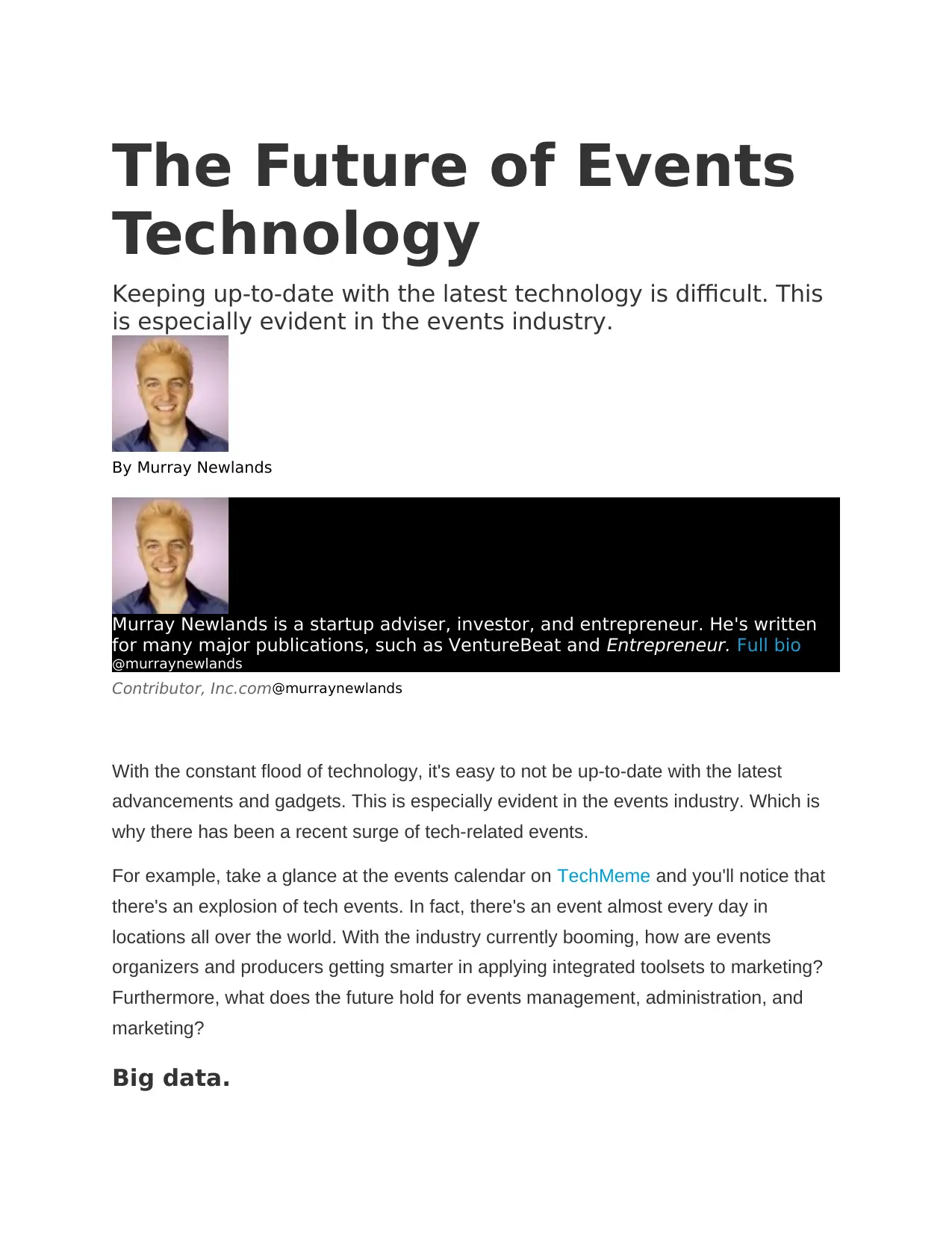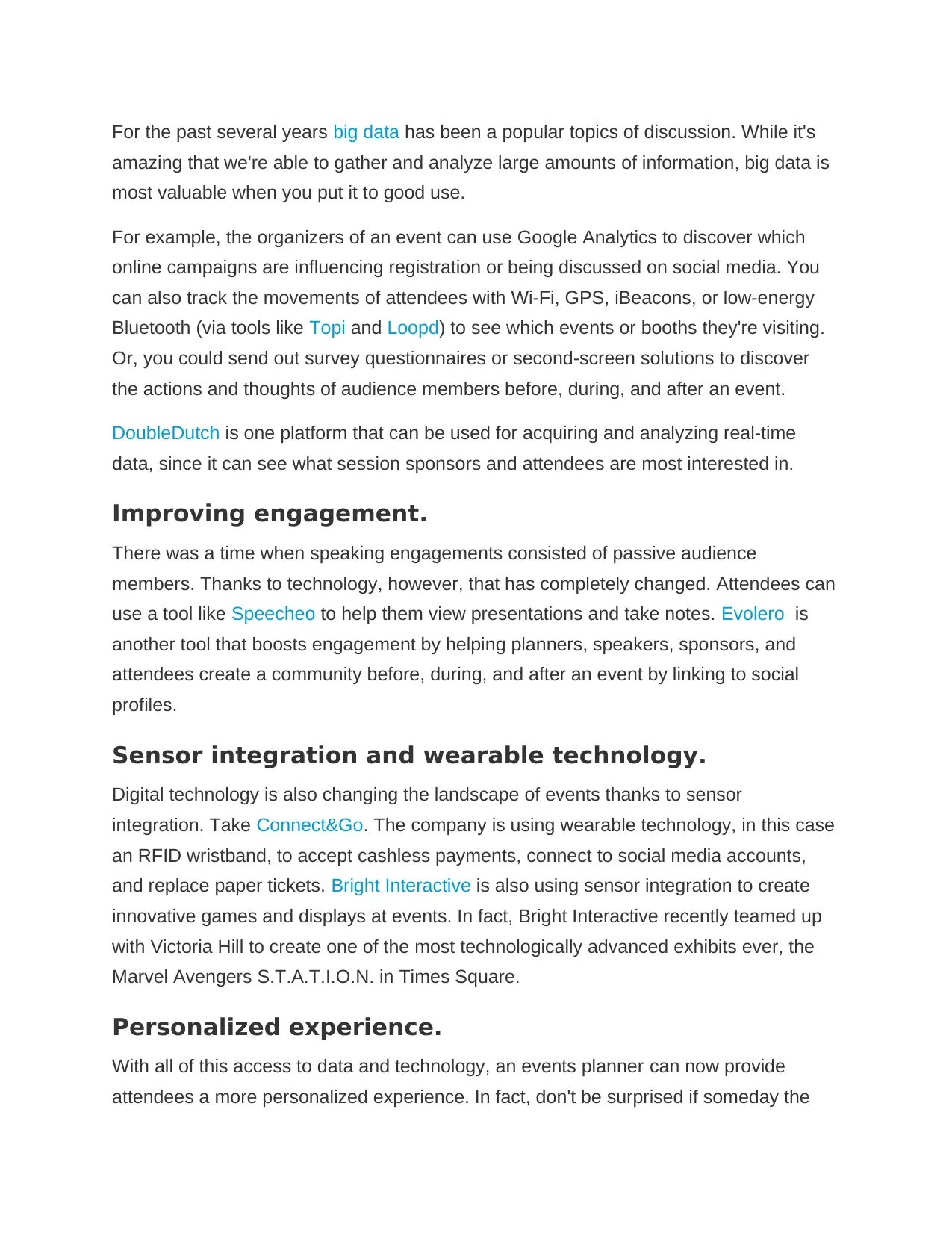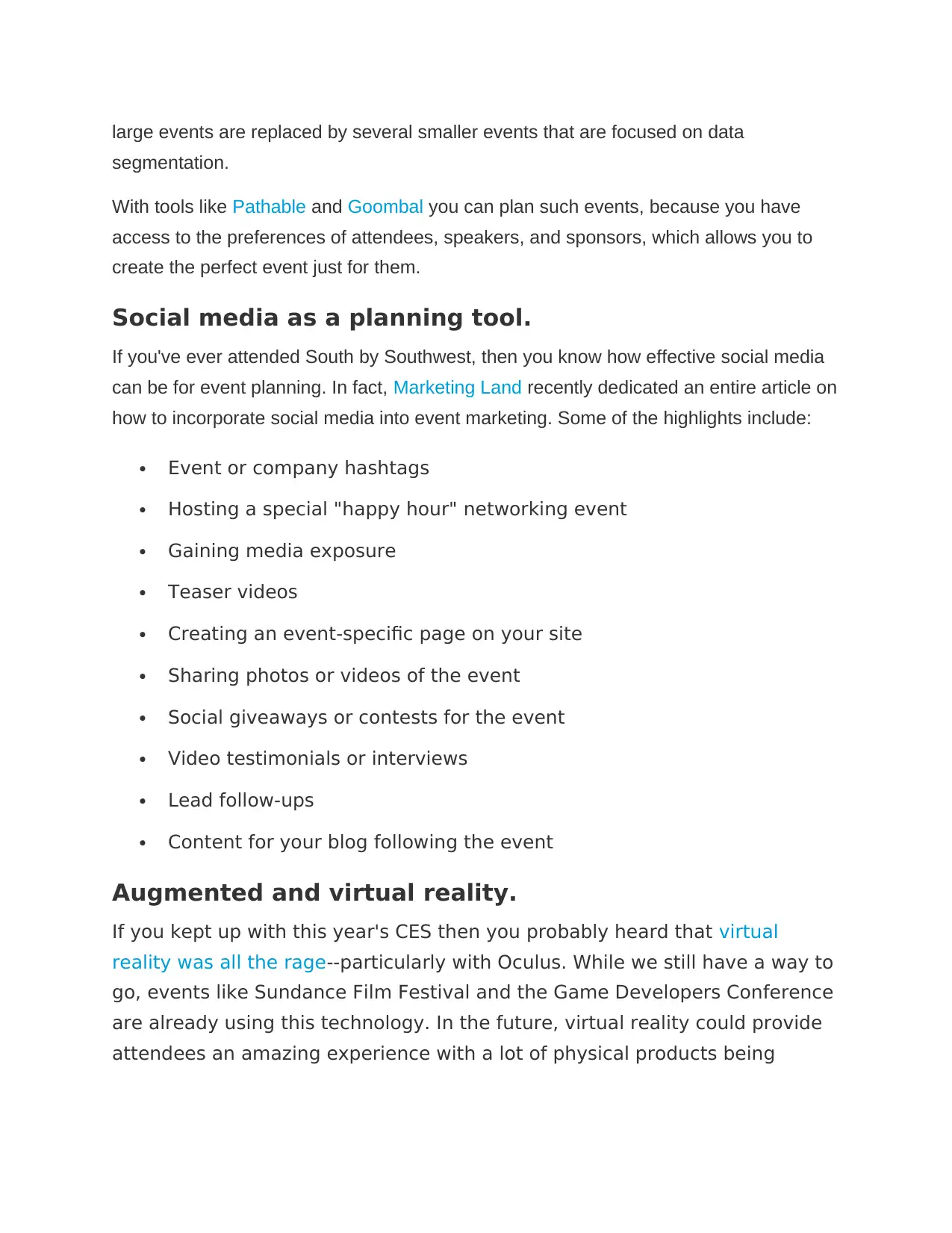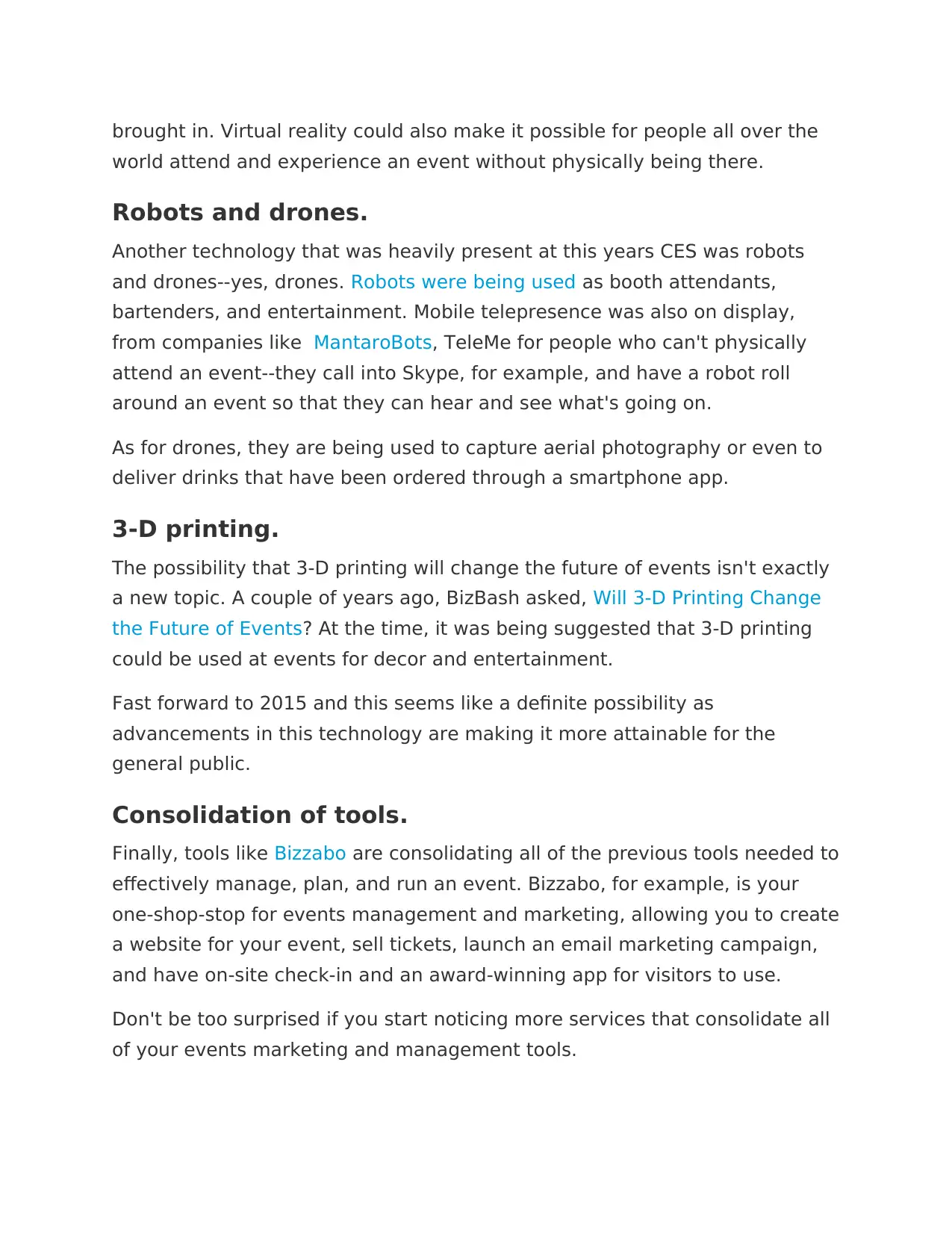The Future of Events Technology: Trends, Tools and Strategies
VerifiedAdded on 2019/09/20
|5
|1158
|300
Report
AI Summary
This report delves into the evolving landscape of events technology, highlighting the integration of cutting-edge tools and strategies. It examines how big data analytics, social media, and sensor integration are transforming event management, enhancing attendee engagement, and personalizing experiences. The report explores the impact of wearable technology, augmented and virtual reality, robotics, drones, and 3D printing on the future of events. It also discusses the consolidation of event management tools and provides insights into how event organizers can leverage these advancements to create more impactful and engaging experiences. The report emphasizes the importance of staying updated with the latest technological advancements to remain competitive in the events industry.

The Future of Events
Technology
Keeping up-to-date with the latest technology is difficult. This
is especially evident in the events industry.
By Murray Newlands
Murray Newlands is a startup adviser, investor, and entrepreneur. He's written
for many major publications, such as VentureBeat and Entrepreneur. Full bio
@murraynewlands
Contributor, Inc.com@murraynewlands
With the constant flood of technology, it's easy to not be up-to-date with the latest
advancements and gadgets. This is especially evident in the events industry. Which is
why there has been a recent surge of tech-related events.
For example, take a glance at the events calendar on TechMeme and you'll notice that
there's an explosion of tech events. In fact, there's an event almost every day in
locations all over the world. With the industry currently booming, how are events
organizers and producers getting smarter in applying integrated toolsets to marketing?
Furthermore, what does the future hold for events management, administration, and
marketing?
Big data.
Technology
Keeping up-to-date with the latest technology is difficult. This
is especially evident in the events industry.
By Murray Newlands
Murray Newlands is a startup adviser, investor, and entrepreneur. He's written
for many major publications, such as VentureBeat and Entrepreneur. Full bio
@murraynewlands
Contributor, Inc.com@murraynewlands
With the constant flood of technology, it's easy to not be up-to-date with the latest
advancements and gadgets. This is especially evident in the events industry. Which is
why there has been a recent surge of tech-related events.
For example, take a glance at the events calendar on TechMeme and you'll notice that
there's an explosion of tech events. In fact, there's an event almost every day in
locations all over the world. With the industry currently booming, how are events
organizers and producers getting smarter in applying integrated toolsets to marketing?
Furthermore, what does the future hold for events management, administration, and
marketing?
Big data.
Paraphrase This Document
Need a fresh take? Get an instant paraphrase of this document with our AI Paraphraser

For the past several years big data has been a popular topics of discussion. While it's
amazing that we're able to gather and analyze large amounts of information, big data is
most valuable when you put it to good use.
For example, the organizers of an event can use Google Analytics to discover which
online campaigns are influencing registration or being discussed on social media. You
can also track the movements of attendees with Wi-Fi, GPS, iBeacons, or low-energy
Bluetooth (via tools like Topi and Loopd) to see which events or booths they're visiting.
Or, you could send out survey questionnaires or second-screen solutions to discover
the actions and thoughts of audience members before, during, and after an event.
DoubleDutch is one platform that can be used for acquiring and analyzing real-time
data, since it can see what session sponsors and attendees are most interested in.
Improving engagement.
There was a time when speaking engagements consisted of passive audience
members. Thanks to technology, however, that has completely changed. Attendees can
use a tool like Speecheo to help them view presentations and take notes. Evolero is
another tool that boosts engagement by helping planners, speakers, sponsors, and
attendees create a community before, during, and after an event by linking to social
profiles.
Sensor integration and wearable technology.
Digital technology is also changing the landscape of events thanks to sensor
integration. Take Connect&Go. The company is using wearable technology, in this case
an RFID wristband, to accept cashless payments, connect to social media accounts,
and replace paper tickets. Bright Interactive is also using sensor integration to create
innovative games and displays at events. In fact, Bright Interactive recently teamed up
with Victoria Hill to create one of the most technologically advanced exhibits ever, the
Marvel Avengers S.T.A.T.I.O.N. in Times Square.
Personalized experience.
With all of this access to data and technology, an events planner can now provide
attendees a more personalized experience. In fact, don't be surprised if someday the
amazing that we're able to gather and analyze large amounts of information, big data is
most valuable when you put it to good use.
For example, the organizers of an event can use Google Analytics to discover which
online campaigns are influencing registration or being discussed on social media. You
can also track the movements of attendees with Wi-Fi, GPS, iBeacons, or low-energy
Bluetooth (via tools like Topi and Loopd) to see which events or booths they're visiting.
Or, you could send out survey questionnaires or second-screen solutions to discover
the actions and thoughts of audience members before, during, and after an event.
DoubleDutch is one platform that can be used for acquiring and analyzing real-time
data, since it can see what session sponsors and attendees are most interested in.
Improving engagement.
There was a time when speaking engagements consisted of passive audience
members. Thanks to technology, however, that has completely changed. Attendees can
use a tool like Speecheo to help them view presentations and take notes. Evolero is
another tool that boosts engagement by helping planners, speakers, sponsors, and
attendees create a community before, during, and after an event by linking to social
profiles.
Sensor integration and wearable technology.
Digital technology is also changing the landscape of events thanks to sensor
integration. Take Connect&Go. The company is using wearable technology, in this case
an RFID wristband, to accept cashless payments, connect to social media accounts,
and replace paper tickets. Bright Interactive is also using sensor integration to create
innovative games and displays at events. In fact, Bright Interactive recently teamed up
with Victoria Hill to create one of the most technologically advanced exhibits ever, the
Marvel Avengers S.T.A.T.I.O.N. in Times Square.
Personalized experience.
With all of this access to data and technology, an events planner can now provide
attendees a more personalized experience. In fact, don't be surprised if someday the

large events are replaced by several smaller events that are focused on data
segmentation.
With tools like Pathable and Goombal you can plan such events, because you have
access to the preferences of attendees, speakers, and sponsors, which allows you to
create the perfect event just for them.
Social media as a planning tool.
If you've ever attended South by Southwest, then you know how effective social media
can be for event planning. In fact, Marketing Land recently dedicated an entire article on
how to incorporate social media into event marketing. Some of the highlights include:
Event or company hashtags
Hosting a special "happy hour" networking event
Gaining media exposure
Teaser videos
Creating an event-specific page on your site
Sharing photos or videos of the event
Social giveaways or contests for the event
Video testimonials or interviews
Lead follow-ups
Content for your blog following the event
Augmented and virtual reality.
If you kept up with this year's CES then you probably heard that virtual
reality was all the rage--particularly with Oculus. While we still have a way to
go, events like Sundance Film Festival and the Game Developers Conference
are already using this technology. In the future, virtual reality could provide
attendees an amazing experience with a lot of physical products being
segmentation.
With tools like Pathable and Goombal you can plan such events, because you have
access to the preferences of attendees, speakers, and sponsors, which allows you to
create the perfect event just for them.
Social media as a planning tool.
If you've ever attended South by Southwest, then you know how effective social media
can be for event planning. In fact, Marketing Land recently dedicated an entire article on
how to incorporate social media into event marketing. Some of the highlights include:
Event or company hashtags
Hosting a special "happy hour" networking event
Gaining media exposure
Teaser videos
Creating an event-specific page on your site
Sharing photos or videos of the event
Social giveaways or contests for the event
Video testimonials or interviews
Lead follow-ups
Content for your blog following the event
Augmented and virtual reality.
If you kept up with this year's CES then you probably heard that virtual
reality was all the rage--particularly with Oculus. While we still have a way to
go, events like Sundance Film Festival and the Game Developers Conference
are already using this technology. In the future, virtual reality could provide
attendees an amazing experience with a lot of physical products being
⊘ This is a preview!⊘
Do you want full access?
Subscribe today to unlock all pages.

Trusted by 1+ million students worldwide

brought in. Virtual reality could also make it possible for people all over the
world attend and experience an event without physically being there.
Robots and drones.
Another technology that was heavily present at this years CES was robots
and drones--yes, drones. Robots were being used as booth attendants,
bartenders, and entertainment. Mobile telepresence was also on display,
from companies like MantaroBots, TeleMe for people who can't physically
attend an event--they call into Skype, for example, and have a robot roll
around an event so that they can hear and see what's going on.
As for drones, they are being used to capture aerial photography or even to
deliver drinks that have been ordered through a smartphone app.
3-D printing.
The possibility that 3-D printing will change the future of events isn't exactly
a new topic. A couple of years ago, BizBash asked, Will 3-D Printing Change
the Future of Events? At the time, it was being suggested that 3-D printing
could be used at events for decor and entertainment.
Fast forward to 2015 and this seems like a definite possibility as
advancements in this technology are making it more attainable for the
general public.
Consolidation of tools.
Finally, tools like Bizzabo are consolidating all of the previous tools needed to
effectively manage, plan, and run an event. Bizzabo, for example, is your
one-shop-stop for events management and marketing, allowing you to create
a website for your event, sell tickets, launch an email marketing campaign,
and have on-site check-in and an award-winning app for visitors to use.
Don't be too surprised if you start noticing more services that consolidate all
of your events marketing and management tools.
world attend and experience an event without physically being there.
Robots and drones.
Another technology that was heavily present at this years CES was robots
and drones--yes, drones. Robots were being used as booth attendants,
bartenders, and entertainment. Mobile telepresence was also on display,
from companies like MantaroBots, TeleMe for people who can't physically
attend an event--they call into Skype, for example, and have a robot roll
around an event so that they can hear and see what's going on.
As for drones, they are being used to capture aerial photography or even to
deliver drinks that have been ordered through a smartphone app.
3-D printing.
The possibility that 3-D printing will change the future of events isn't exactly
a new topic. A couple of years ago, BizBash asked, Will 3-D Printing Change
the Future of Events? At the time, it was being suggested that 3-D printing
could be used at events for decor and entertainment.
Fast forward to 2015 and this seems like a definite possibility as
advancements in this technology are making it more attainable for the
general public.
Consolidation of tools.
Finally, tools like Bizzabo are consolidating all of the previous tools needed to
effectively manage, plan, and run an event. Bizzabo, for example, is your
one-shop-stop for events management and marketing, allowing you to create
a website for your event, sell tickets, launch an email marketing campaign,
and have on-site check-in and an award-winning app for visitors to use.
Don't be too surprised if you start noticing more services that consolidate all
of your events marketing and management tools.
Paraphrase This Document
Need a fresh take? Get an instant paraphrase of this document with our AI Paraphraser

The opinions expressed here by Inc.com columnists are their own, not those of Inc.com.
PUBLISHED ON: MAR 11, 2015
PUBLISHED ON: MAR 11, 2015
1 out of 5
Your All-in-One AI-Powered Toolkit for Academic Success.
+13062052269
info@desklib.com
Available 24*7 on WhatsApp / Email
![[object Object]](/_next/static/media/star-bottom.7253800d.svg)
Unlock your academic potential
Copyright © 2020–2025 A2Z Services. All Rights Reserved. Developed and managed by ZUCOL.